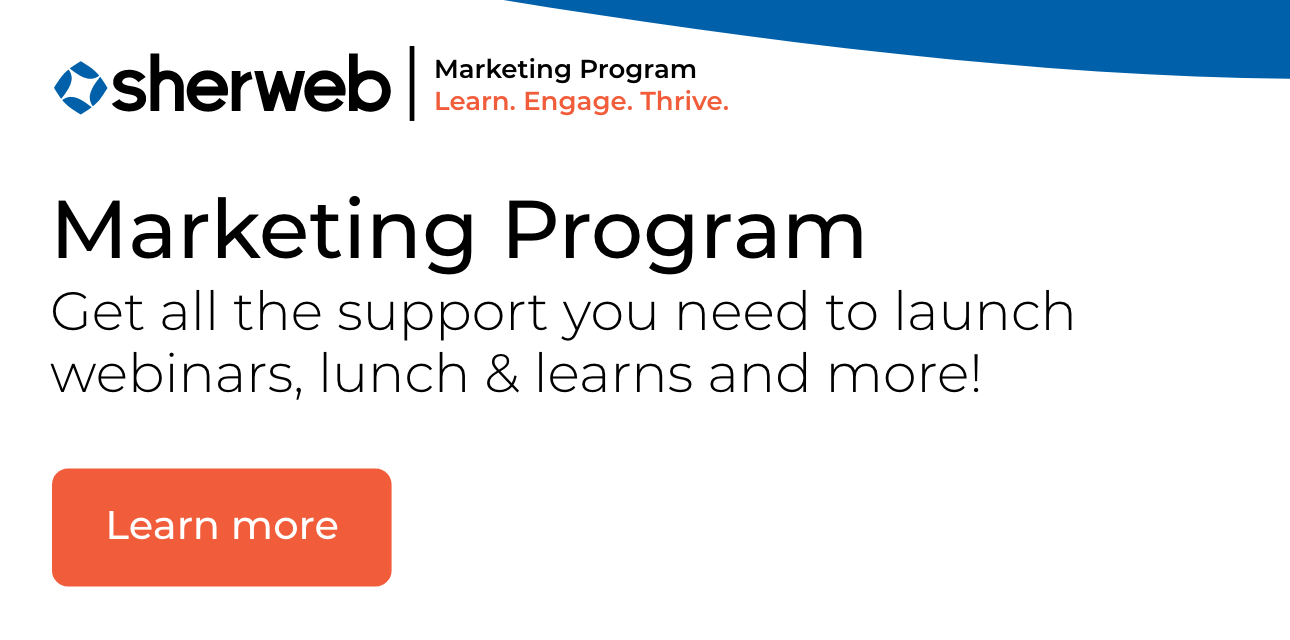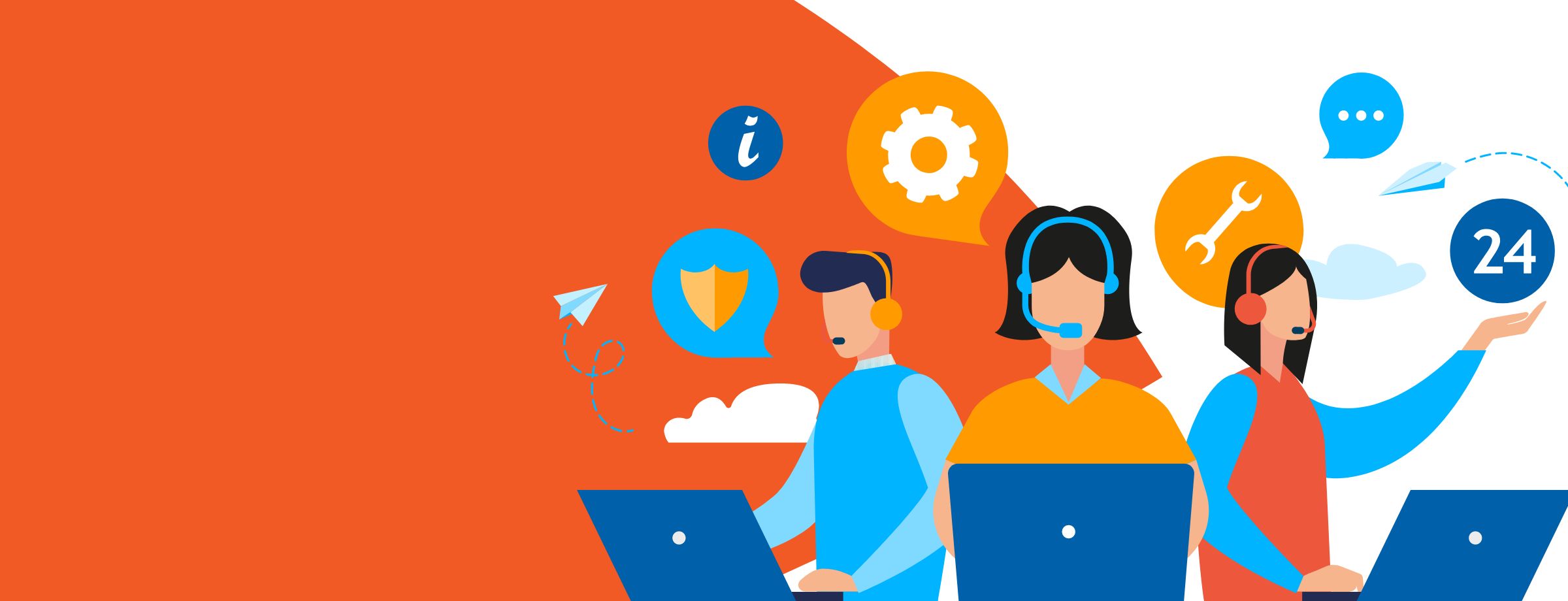We’ve noticed something about managed service providers (MSPs): they’re often bad at leveraging vendors! But honestly, it’s not your fault. Some vendors like Microsoft are very intimidating. They’re big beasts with massive ecosystems to scour for what’s usable and leverageable!
Sherweb has a wide array of value-added services to help MSP partners make sense of it all. We provide 1-1 MPN consultations, as well as guidance on Microsoft’s incentives and co-op funds available to partners, including what you can do to leverage them with the greatest ROI.
Microsoft partner incentives and co-op funds
What are co-op funds? As Microsoft puts it: “The Partner Incentives Cooperative Marketing Fund (Coop) provides reimbursements of earned funds to participating partners to help differentiate and build channel awareness and preference for Microsoft® products”. With these funds, you’ll be able to develop marketing strategies to gain leads, promote your brand, incentivize your sales and more. Also know that you can find all the details in Microsoft’s partner network portal. You can also check out the 10 essentials for working with incentives by Microsoft.
Before we dive deeper…
Eligibility
You can find the specific eligibility requirements for your program in the program guide.
- Sign into the Partner Center dashboard
- Under Incentives on the left nav, select Overview. The Program overview page opens.
- Select the program you want.
- In the Program details field, select Program Guide.
Activity periods breakdown
- FY21, H1: July 1, 2020 – December 31, 2020
- FY21, H2: January 1, 2021 – June 30, 2021
Earning/Accrual Period
|
Usage Period
|
| Claiming Period Deadlines Submit reimbursement claims:
|
Proof of Execution (POE) Approval Deadlines Obtain POE approval by
|
Earning period: The six-month period during which you accrue your earnings. You must use these earnings at some point during the following six-month.
Usage period: If you don’t use your earn>ings by the end of the usage period, you’ll forfeit them.
Claiming period: the six-month period during which you can claim reimbursement for your incentive program activities.

The table below shows the different earning, usage, and claiming periods. Unless otherwise noted, periods extend from the first day of the first month to the last day of the last month.
| If your Earning/accrual period is | Your fiscal half-year period is | Your Usage period is | Your Claiming period is |
| July – Dec 2020 | FY20 H1 | Jan – June 2021 | Feb 16 – Aug 15 2021 |
| Jan – June 2021 | FY20 H2 | July – Dec 2021 | Aug 16 2021 – Feb 15 2022 |
| July – Dec 2021 | FY21 H1 | Jan – June 2022 | Feb 16 – Aug 15 2022 |
| Jan – June 2022 | FY21 H2 | July – Dec 2022 | Aug 16 2022 – Feb 15 2023 |
If an activity spans multiple usage periods, and there’s a milestone delivery date with an invoice in-between those periods, the partner may submit a claim for the portion within the usage period that was invoiced.
The lowdown on the funds
During the earning period, Microsoft will calculate 60% of global incentive earnings to be paid as monthly rebate and 40% of global incentive earnings will be placed into a co-op fund to use for approved activities executed in the co-op usage period.
| Incentive | Rebate Split | Co-op Split |
| Global Incentives – Core incentives | 60% | 40% |
| Global Incentives – Azure Reservation and Subscription software | 100% | – |
| Strategic Accelerators | 60% | 40% |
| Local Accelerators | 100% | – |
If a partner’s co-op earnings are below the threshold of $10K USD in a co-op earning period, the co-op earnings will be converted to rebate at the end of the semester.
How to earn incentives
To be eligible for participation, a partner must have an active MPN membership and agreement. Partners must perform all registration requirements and qualifying activities—as stated in the incentives guide before the incentive can be earned.
| Competency | Active Gold or Silver membership in one of the eligible competencies:
Cloud Business Applications, |
| Partner Agreement | Microsoft CSP Indirect Reseller Channel Authorization |
| Partner Center | Valid and complete identification, tax and banking information submitted and accepted by Microsoft |
| Program Term | October 1, 2020 – September 30, 2021 |
How much you can earn
This incentive program includes global, local and co-op components. The rates for the FY21 incentive program year will be in effect from October 1, 2020 to September 30, 2021.
| Incentive structure | Rate | Earning split |
| Core
Azure billed revenue> |
4% | 60% rebate 40% Co-op |
| Core
Modern Work & Security billed revenue |
4% | |
| Core
Business Applications billed revenue |
4.75% | |
| Customer Add Accelerator
Modern Work & Security |
10% | |
| Customer Add Accelerator
Business Applications |
20% | |
| Global Strategic Product Accelerator
Tier 1 |
5% | |
| Global Strategic Product Accelerator
Tier 2 |
10% | |
| Global PSTN Calling and Conf Accelerator | 20% | |
| Azure Reservation consumption | 10% | |
| Subscription software | Core: 1.25% Strategic: 6% |
100% rebate |
What does this mean for your business?
Microsoft says that if a partner’s co-op earnings are below the threshold of $10K USD in a co-op earning period, the co-op earnings will be converted to rebate at the end of the period. You’ll also need your competencies to qualify. Microsoft offers two levels of competencies: Silver Competency and Gold Competency. They will help you showcase your capability and expertise in delivering specific solutions. The solutions are listed in the table above. This proven expertise will also help your brand and the positioning of your business as an expert for your leads and clients. Note that a silver competency will cost $1,670/year and a gold competency will be $4,730/year. The good news is that when the time comes for your silver or gold membership renewal, you will be able to claim those fees from the coop funds as an eligible activity.
Let’s talk eligible marketing activities
The guidebook goes over each and every eligible marketing activity you can claim. There’s a lot of information, and a lot that can be claimed! However, because we each have a limited amount of hours in our days, I thought I would cover two things:
- The activities with which Sherweb can provide help or content for
- Our recommended eligible marketing activities based on what works for our partners
Feel free to jump ahead to the activities you’re the most curious about, but we strongly recommend reading through because not only are these recommended activities eligible to claim co-op funds from Microsoft, they’re also good to include in a broader marketing plan for an MSP.
How Sherweb helps
If you take a look at the co-op incentive guidebook, you’ll probably notice there’s a really large amount of activities covered. To make sure you gain speed and quickly, I thought I would cover the content we make available for you to use and claim.
Sherweb’s marketing program is packed with assets you can leverage to position Microsoft’s Modern Workplace portfolio. You can use the full-funnel approach to claim multi-touch digital campaigns, or run webinars only. It’s up to you! You can plan your activities and use the assets however you want, but straight out of the box, the program fits under the multi-touch digital campaign requirements. The campaigns are meant to leverage a mix of touchpoint and tactics and with co-op funds. You can claim the ad spend, as well as any collateral you’d like to add to the current mix. You can pair campaigns with some direct mail or telemarketing to improve your success rate and claim fees for these initiatives as well.
If you choose to leverage webinar assets only, or host your lunch and learn digitally, know that all the fees related to that initiative could also be claimed under the Customer Seminars and boot camps activity in the guidebook. The giveaways, agency fees, external speaker fees or catering can also be claimed under these guidelines.
From Microsoft’s incentives co-op guidebook:
Multi-touch digital campaign
Allows Partners to claim expenses for a digital multi-media campaign that may be comprised of several co-op activity components under one eligible activity type, rather than multiple activity types within the tool. Digital marketing activities which can be grouped and claimed under Multi-touch digital campaign include digital advertising, social media marketing, direct email, partner website and search engine optimization, and telemarketing.
Customer seminars are Microsoft-focused customer and reseller-facing training and recruitment, utilizing content developed by the partner. Digital events such as podcasts, video on demand, simulcasts, hands on lab online and other virtual seminar events are also eligible. Microsoft bootcamps are reseller-facing training events hosted by the partner, utilizing specific Microsoft presentation materials and Microsoft centralized registration. Customer seminars or Microsoft bootcamps must meet the core requirements. No proportional reimbursement is allowed for events that do not meet the core requirements. Events must be partner-led and partner-branded and not appear to be “sponsored by” Microsoft.
We can also help you make the most out of your incentives and co-op funds through Sherweb’s added-value approach. Our MPN consultation services, marketing consultation services and training opportunities can give you ideas and strategies you might’ve missed. The consultations can also help you pinpoint growth or strategy opportunities to maximize your partnership with Microsoft. We can also offer expert training for Microsoft’s competencies and exams through third parties and help you claim any related fees.
Recommended activities
We’ve heard a lot of partners say that this year is the year for marketing. But there’s often hesitation on where to start and budget is always an issue. Here, we’ve highlighted the eligible activities I recommend based on ease of claim, impact on growth and ROI and other areas of focus for most of our partner base. Let’s dive in!
Microsoft’s MPN participation, Microsoft exams and tuition
One of the easiest and probably most useful ways to leverage co-op funds is to pay for the competencies that give you access to those funds in the first place. To get co-op funds you need to meet the revenue threshold, but even before that, you need a Silver or Gold competency. With the funds, you can cover the annual MPN enrollment fees, the competency exam and also the training fees.
From Microsoft’s incentives co-op guidebook:
MPN participation
Includes Microsoft Partner Network (MPN) annual enrollment fees, MPN membership plaque and first set of DVDs and Additional Benefit Toolkit.
| Category | Proof of execution |
| Core requirements | Original Microsoft invoice |
| Communications requirements | NA |
| Metrics | NA |
| Eligible expenses | Fee – Annual enrollment: MPN annual registration fees
Plaque and DVD (first set): MPN membership plaque and first set of DVDs Additional Benefit Toolkit |
Microsoft exams and tuition
Official Microsoft exam and tuition fees for certifications and competencies available at www.microsoft.com/learning.
-
- Claims should be filed in the period during which the training activity occurred and after the exam/training is completed.
- Training vouchers may only be claimed after the completion of a training course. Partners must submit invoices for the vouchers and provide a certificate or a completion document that states the dates the course was taken and completed.
- If the invoice does not include the course/exam code and date of completion, be prepared to show an alternative form of course completion, such as a course certificate.
| Category | Proof of execution |
| Core requirements | Course code/exam code on Microsoft Learning |
| Communications requirements | Third-party invoice with course code and date of completion or invoice with exam code and date of completion |
| Metrics | Attendee list and per person cost |
| Eligible expenses | Fee – exam: Microsoft exam fees for certifications and competencies
Fee – training/tuition: Microsoft tuition fees for certifications and competencies, including on-demand training expenses Third-party ISV solution training – tuition expenses for training on third-party solutions that can be demonstrated to leverage or reside on Microsoft applications and platforms Fee – MCT renewal: Microsoft Certified Trainer renewal fee (no metric required) |
Caution
Co-op funds will only cover predefined course materials, as listed on www.Microsoft.com/learning in relation to a completed course/exam
Are training vouchers eligible for Co-op funds?
Training vouchers may only be claimed after the completion of a training course. Partners must submit invoices for the vouchers and provide a certificate or a completion document that states the dates the course was taken and completed.
SPIFF
Internal incentives and sales performance incentive funds (SPIF or SPIFFs) are also eligible to be claimed. Find new ways to incentivize your sales representatives, or technicians, on Microsoft content sales and claim up to 25% of your allocated maximum funds. If you’re looking to use every cent of the co-op funds you receive, but don’t have an established marketing plan, marketing agency or internal marketing resources, it can be challenging to figure out how to use that without losing a large chunk of your precious time. SPIFFs are a good way to claim that money and have it make an impact on your bottom line.
Reps love money. They also love a good competition. Appeal to that by devising a sales incentive plan. Offer them great rewards and watch them close more deals! You can claim the giveaway, signage and any printed material you might have used to drive your internal contest.
From Microsoft’s incentives co-op guidebook:
Internal incentives and SPIFFs
Internal incentives and sales performance incentive funds (SPIFFs) are activities in which prizes are awarded to partner employees (for example, sales staff) for achieving specific goals or for sales teams for winning sales contests.
- Must be determined based on overall achievement relative to a peer group. Should not be awarded based on individual minimum commitments, first unit structures, attach rates, year-over-year growth percentage, or volume targets (not applicable for Surface partners).
- Giveaway items must adhere to Microsoft guidelines.
- The SPIFF giveaway expense of a floor day should be claimed under this activity. Other general event expenses for a floor day event should be claimed under “Internal Training and Floor Day”.
| Category | Proof of execution |
| Core requirements | Company brand name and contact information – internal contest rules will suffice if the company/brand name is included in the communication material
Microsoft content |
| Communications requirements | Show offer with terms and conditions. Actual costs up to 25% total of earned co-op funds per usage period |
| Metrics | Summary of results |
| Eligible expenses | Actual costs up to 25% total of earned co-op funds per usage period for: signage, display, printed materials Giveaways Fee – agency: Marketing services, including agency fees |
SPIFFs should leverage key performance indicators (KPIs) to structure the payout, require that a minimum eligibility threshold be attained and place a cap on the award payable. SPIFFs cannot be used by the partner to achieve a lower street price as the partner must pay them to partner employees.
Reminders
- Do not include Microsoft software except as specified.
- Cash/cash equivalent is an acceptable giveaway for SPIFFs.
- The Internal Incentive and SPIFFs activity now requires an attestation form to be populated as part of the claim creation process. This applies to all programs on Partner Center, it is not applicable to the Commercial Distributor program.
Best practices
Internal incentives/SPIFFs are most effective when clear goals and timelines are set and the incentive is related to those goals.
Website and SEO
This one is a no brainer. We’ve lost count of all the partners and MSPs looking to refresh their website and gain more visibility with search engine optimization (SEO). The fun part is that SEO for MSPs is a continuous operation, too. So if you just redid your website, you can still make sure it’s bringing you the most visibility online to fuel your digital word-of-mouth engine. A continuous look at your rankings, competitive field and keywords can only benefit you in the long run, and the fees are all eligible to be claimed. So don’t leave that activity—and money—on the table to waste away!
Even if you have no other activities planned, this one should definitely be on your radar. A professional, up to date, optimized website will make your brand and other tactics look the most legit. We always say an image is worth a thousand words—well, in branding and positioning, awebsite is worth a thousand images! Even if all you do is direct mail or telemarketing, people WILL Google you to validate who you are, what you do and if your business is of any interest. Make sure you’re online, findable and looking sharp.
From Microsoft’s incentives co-op guidebook:
Partner website and search engine optimization
Creation of a partner website/microsite or content hosted on a partner-owned website or a partner’s social media site. Includes e-commerce activities to promote solutions or set up online storefronts to drive sales of Microsoft products and solutions and mobile e-commerce efforts such as the development of a mobile-friendly website (web responsive design) or mobile application. SEO includes website optimization services to help attract customers, lower customer acquisition costs and increase content relevancy to a website.
- The complete activity, including the website or microsite being claimed and any associated web content, must meet the core requirements as a whole.
- Services for search engine optimization may be acquired through Microsoft Pinpoint Marketplace, DigitalStride or your local SEO agency.
- Activities must be completed in the period the claim is filed.
- Paid promotion/advertising on a social media site should be claimed under Social media marketing activity.
| Category | Proof of execution |
| Core requirements | Review specific guidelines on the Activity Guidelines: Core Requirements slide. |
| Communications requirements | URL and/or screenshots of site page(s) showing URL
Statement of work or service agreement for SEO project (SEO activity only) |
| Metrics | Summary of results (such as click-through report) |
| Eligible expenses | Fee – agency: Marketing services, including agency fees
Programming/development: Programming and development fees Fee – SEO: Optimization and maintenance fees |
Best practices
- Key Product pages help create value by showing additional benefits to products; include an “Add to Cart” or “Buy Now” link to drive sales.
- Place banners on key pages, including the home page, that link to product pages to foster better measurements of results while expanding communication opportunities.
- Create up-sell or cross-sell opportunities by configuring dropdown menus with Microsoft products.
- Do not limit your SEO to just keywords.
- Set measurable goals before execution to gauge effectiveness.
Multi-touch digital campaigns
We’re big fans of the full-funnel, multi-touch approach. If you have a marketing plan—or even just a draft of a plan—you’re probably planning multi-touch campaigns already. Don’t let the name stop you; all it means is that you’re planning to execute some marketing activities that are all part of the same campaign. You could be planning to send a piece of direct mail with a link to a landing page. That landing page can host an eBook or a webinar invitation. You could be planning to follow up that mailing with some calls from your sales team or a telemarketing firm. All these activities tie in together to form a multi-touch campaign.
A lot of marketers are strong with this type of campaign, including Robin Robins and her Technology Marketing Toolkit. If you’re a member and have been wanting to try one of her campaigns, then know that if it’s used to position your Microsoft offerings, you could be claiming the money needed for print materials, telemarketing or design fees. This is just one example of a multi-touch campaign. Our Marketing Program campaigns is another. Your own marketing plan, or future plan, probably includes other examples. Dig into this eligible activity to know more and see what you can do.
From Microsoft’s incentives co-op guidebook:
Multi-touch digital campaign
Allows Partners to claim expenses for a digital multi-media campaign that may be comprised of several co-op activity components under one eligible activity type, rather than multiple activity types within the tool. Digital marketing activities which can be grouped and claimed under Multi-touch digital campaign include digital advertising, social media marketing, direct email, partner website and search engine optimization, and telemarketing.
- Complete campaign activity must meet all guidelines and requirements for each individual activity type, as detailed on the applicable activity page in the Co-op Guidebook.
- All proof of execution for each activity type included in the campaign is required.
- Provide a marketing plan or other statement of work in the claim, which outlines the eligible activities included as part of the campaign in order to easily claim reimbursement for eligible expenses.
| Category | Proof of execution |
| Core requirements | Review specific guidelines on the Activity Guidelines: Core Requirements slide. |
| Communications requirements | All Proof of Execution as detailed in the applicable activity page is required
Third party invoice or certification statement and report (CSR) |
| Metrics | NA |
| Eligible expenses |
|
Best practices
Work with a marketing agency to create successful multi-touch digital campaigns that have an easily identified ROI and build customer pipeline.
Did you know?
Microsoft’s Partner Marketing Center offers resources for partners to easily build multi-touch campaigns. Visit smartpartnermarketing.microsoft.com for more information.
Digital advertising
MPSs can be reluctant to dabble in digital marketing because it takes a different kind of expertise, as well as a marketing budget. The good news is that these are eligible activities in the Microsoft incentives co-op guidebook. That means that any third-party fee or ad spend you put towards Microsoft product won’t be coming out of your pocket. Still have doubts? Did you know that small businesses earn an average of $3 in revenue for every $1.60 they spendon Google AdWords? Not too shabby!
From Microsoft’s incentives co-op guidebook:
Digital advertising
Includes web banners and online advertising placed on a third-party website or third-party email and is designed to drive traffic to the Partner’s website or offer page. Also includes search engine marketing (SEM) and pay-per-click (PPC) advertising.
- Complete digital advertisement, including web banner/advertisement and landing page must meet the core requirements. Landing page refers to the website/offer page where customers are directed when they click on the digital advertisement posted on a third-party website.
- Web/online advertisements should be placed on a third-party site with an established advertising rate, of which not more than 10% is partner-owned. Digital content that is hosted on a partner-owned website should be claimed under “Partner Website and Search Engine Optimization” activity.
| Category | Proof of execution |
| Core requirements | Review specific guidelines on the Activity Guidelines: Core Requirements slide. |
| Communications requirements | Screenshot of digital advertisement
AND URL of landing page, showing program-specific core requirements |
| Metrics | Summary of results (such as click-through report) |
| Eligible expenses | Third-party media placement
Fee – agency: Marketing and creative services, including agency fees |
Telemarketing
Transparency alert: we’re recommending this tactic based on some mixed data. A lot of our partners have run telemarketing efforts and have seen different levels of successes. We think telemarketing is a good tactic in multi-touch campaigns, or paired with other initiatives, to contact leads who have engaged with your brand before. We do not like telemarketing as a first touch with cold or bought leads. Just like you don’t like getting calls out of the blue from companies you’ve never heard of, potential leads from a purchased list feel the same way. Use it right, and leverage the tactic cleverly, as part of a broader marketing strategy.
From Microsoft’s incentives co-op guidebook:
Telemarketing
Calling partners/customers or potential customers to promote and sell Microsoft products, services, solutions, or platforms. It can be an effective tool to prospect for leads, communicate directly with customers, and build a sales pipeline. Telemarketing activities must be partner-led and not appear to be from Microsoft. Microsoft products must be properly referenced in the script.
| Category | Proof of execution |
| Core requirements |
|
| Communications requirements | Copy of script |
| Metrics | Summary of results (number of calls and number of successful contacts) |
| Eligible expenses |
|
Reminders
- Indicate that the call is from your company and not from Microsoft.
- Use the correct trademarked name for software in the script and include the specific Microsoft product being promoted.
- Use for special initiatives.
Best practices
- Focus on communicating the most important message and driving a response.
- Appeal to Customer by meeting a specific need.
- Use a targeted call list.
- Test multiple offers to determine impact
Customer seminars and bootcamps – webinars/podcasts
If anything, 2020 is the “year of the webinar”. With the pandemic, most in-person seminars, boot camps and live events have been cancelled—or should have been. Brands have turned online to host their events, and each are trying out different ways of being different. Some have contests, others gift cards or draws and the most ambitious try virtual cooking lessons or wine tastings.
Whatever you’re planning to cut through the noise, don’t go against the nature of your brand voice and stay focused on your message. Don’t conduct initiatives just to be flashy. Be original, but not tacky. Webinars are always a good way to educate and inform. It’s great as awareness or consideration stage content. Use it to fill your pipeline with new leads, or target current clients to present new bundles or upsell/cross sell opportunities. You can leverage Microsoft’s funds to help pay for guest speakers, agency fees, catering (gift cards), etc.
From Microsoft’s incentives co-op guidebook:
Customer seminars and bootcamps
Customer seminars are Microsoft-focused customer and reseller-facing training and recruitment, utilizing content developed by the partner. Digital events such as podcasts, video on demand, simulcasts, hands on lab online, and other virtual seminar events are also eligible. Microsoft bootcamps are reseller-facing training events hosted by the partner, utilizing specific Microsoft presentation materials and Microsoft centralized registration. Customer seminars or Microsoft bootcamps must meet the core requirements. No proportional reimbursement is allowed for events that do not meet the core requirements. Events must be partner-led and partner-branded and not appear to be “sponsored by” Microsoft.
- Microsoft business model transformation consultants may be leveraged as external speakers to deliver workshops.
- Giveaway Items and event claiming for customer seminars and bootcamps must adhere to Microsoft guidelines.
- When conducting digital events, an image of the initial welcome screen of the webinar should be submitted in place of the event photos.
| Category | Proof of execution |
| Core requirements |
|
| Communications requirements |
|
| Metrics | Number of registered guests |
| Eligible expenses |
|
Did you know…
Distributors participating in both the Authorized OEM Distributor incentives and Commercial Distributor co-op programs may claim the appropriate percentage of OEM and/or commercial business-focused event expenses under the respective programs. Proof of execution must designate the percentage of total expenses applied to each program.
Best practices
- Customize your strategy based on the unique needs of your business and customers.
- Provide giveaway items to attract attendees, increase participation, and collect customer information.
Customer offers
Customer what-now? Think of customer offers like SPIFFs, but for your clients and/or leads. They’re promotions and contests created to generate interest in a product or solutions. They’re easy to claim simply because you can use 25% of your earned funds directly for a customer offer, same as the SPIFF. To make this easy claim successful, however, you’ll need to target the right audience and see what could make them tick! Make sure that the offer is closely related to the benefit or the solution it’s meant to promote. Don’t give out something so bedazzled that it takes the spotlight and eclipses the promotional message or value associated with your services.
From Microsoft’s incentives co-op guidebook:
Customer offers
Customer offers are customer or thru-partner marketing activities with promotional giveaway items offered to customers/resellers/channel partners to create excitement, generate sales opportunities, and reward outstanding sales performance.
- Should not advertise bundles or include a discount on a bundle which includes software.
- Should not be awarded based on first unit structures.
- Giveaway Items must adhere to Microsoft guidelines.
| Category | Proof of execution |
| Core requirements | Microsoft content |
| Communications requirements | Show offer with terms and conditions. Actual costs up to 25% total of earned co-op funds per usage period. Surface partners may claim up to 100% of earned co-op funds per usage period for eligible activity expenses. |
| Metrics | Summary of results |
| Eligible expenses |
|
Reminders
- Target your offers to the right audience.
- What if giveaway items do not comply with the Core Requirements? Giveaway items that cannot physically contain the core requirements must include supporting communication material that demonstrates the core requirements. Examples include advertisement, direct mail, or a brochure.
On-site champ
This one’s a doozy, but easy to claim. Microsoft allows you to use your funds to hire or fund someone’s salary internally. All that’s needed is for that resource to be fully dedicating to promoting Microsoft’s portfolio. In truth, you can use these funds to fund sales reps or even yourself, if you’re a CSP partner and want to develop your Modern Workplace market share, for example.
From Microsoft’s incentives co-op guidebook:
On-site champ
The On-site champ activity is an allowance for the use of co-op funds for Microsoft-focused services, such as leading and coordinating marketing or sales campaigns, provided by current or hired, full or part-time partner resource(s) (employees or vendor-contracted) that demonstrate clear business development results such as Microsoft solutions competitive wins and sales uplift. These services should be for specific Microsoft-focused sales and marketing initiatives, or strategic incubation projects that are covered by the eligible co-op funds.
- Specific marketing activities driven by the On-Site Champ (for example, telemarketing) must be claimed separately under the applicable activity categories and must meet the core requirements.
- On-Site Champ can be a current or hired, full or part-time partner resource(s) (employees or vendor-contracted) to perform Microsoft-focused sales and marketing initiatives, or strategic incubation services.
- In cases where the On-Site Champ is an employee of the partner, a CSR form must be populated as proof of execution. In cases where the On-Site Champ is a vendor-contracted resource, an invoice will be required as proof of execution.
- Can include projects that extend beyond the current fiscal period, and co-op funds that are available to the partner in subsequent fiscal periods can be used to fund services provided by On-Site Champ for these projects within the policy guidelines.
| Category | Proof of execution |
| Core requirements | Services focused 100% on Microsoft products |
| Communications requirements | Sample of deliverables (based on what is described in the On-site Champ form) |
| Metrics | NA |
| Eligible expenses | Actual costs up to 50% of earned co-op funds per usage period for: Fees – services: Services provided by On-Site Champ resource(s) |
Conditions to claim to Microsoft
Content must support the marketing and promotion of Microsoft products. If the services marketed by the partner do not clearly show a Microsoft component, the partner must provide supporting documentation which describes the Microsoft product, service, solution or platform that the partner service or solution is based on.
A minimum of 100% Microsoft-focused content for the following activities:
- On-site champ
- Internal training and floor days
- On-demand training
A minimum of 75% Microsoft-focused content for the following activities: Social media marketing
Useful resources
- To claim your funds, you’ll need to follow Microsoft’s guidelines
- The complete Partner Incentive Co-op Guidebook
Now that’s what I call a deep dive
Alright, that was a lot of information. Hopefully you found some information to help you use those funds to their full potential! Maybe it also helped you realize that you can claim those funds, giving your marketing a well intended kick in the behind. Our goal is really to help you grow and help you leverage everything you can to make that happen. MPN consultations are a part of our offering here, so make sure that if you have any doubts, you engage with your account management team.
In the meantime, make sure to check out our marketing program and the campaigns within it. Even if you don’t qualify for Microsoft’s co-op funds, the white-label campaigns within the program can help you go to market and position your offerings strategically.





